Corsair Neutron GTX SSD Review (240GB): Link A Media Controller Tested
by Anand Lal Shimpi on August 20, 2012 6:00 AM EST- Posted in
- Storage
- SSDs
- Corsair
- Neutron
- Link a Media
AnandTech Storage Bench 2011
Two years ago we introduced our AnandTech Storage Bench, a suite of benchmarks that took traces of real OS/application usage and played them back in a repeatable manner. I assembled the traces myself out of frustration with the majority of what we have today in terms of SSD benchmarks.
Although the AnandTech Storage Bench tests did a good job of characterizing SSD performance, they weren't stressful enough. All of the tests performed less than 10GB of reads/writes and typically involved only 4GB of writes specifically. That's not even enough exceed the spare area on most SSDs. Most canned SSD benchmarks don't even come close to writing a single gigabyte of data, but that doesn't mean that simply writing 4GB is acceptable.
Originally I kept the benchmarks short enough that they wouldn't be a burden to run (~30 minutes) but long enough that they were representative of what a power user might do with their system.
Not too long ago I tweeted that I had created what I referred to as the Mother of All SSD Benchmarks (MOASB). Rather than only writing 4GB of data to the drive, this benchmark writes 106.32GB. It's the load you'd put on a drive after nearly two weeks of constant usage. And it takes a *long* time to run.
1) The MOASB, officially called AnandTech Storage Bench 2011 - Heavy Workload, mainly focuses on the times when your I/O activity is the highest. There is a lot of downloading and application installing that happens during the course of this test. My thinking was that it's during application installs, file copies, downloading and multitasking with all of this that you can really notice performance differences between drives.
2) I tried to cover as many bases as possible with the software I incorporated into this test. There's a lot of photo editing in Photoshop, HTML editing in Dreamweaver, web browsing, game playing/level loading (Starcraft II & WoW are both a part of the test) as well as general use stuff (application installing, virus scanning). I included a large amount of email downloading, document creation and editing as well. To top it all off I even use Visual Studio 2008 to build Chromium during the test.
The test has 2,168,893 read operations and 1,783,447 write operations. The IO breakdown is as follows:
| AnandTech Storage Bench 2011 - Heavy Workload IO Breakdown | ||||
| IO Size | % of Total | |||
| 4KB | 28% | |||
| 16KB | 10% | |||
| 32KB | 10% | |||
| 64KB | 4% | |||
Only 42% of all operations are sequential, the rest range from pseudo to fully random (with most falling in the pseudo-random category). Average queue depth is 4.625 IOs, with 59% of operations taking place in an IO queue of 1.
Many of you have asked for a better way to really characterize performance. Simply looking at IOPS doesn't really say much. As a result I'm going to be presenting Storage Bench 2011 data in a slightly different way. We'll have performance represented as Average MB/s, with higher numbers being better. At the same time I'll be reporting how long the SSD was busy while running this test. These disk busy graphs will show you exactly how much time was shaved off by using a faster drive vs. a slower one during the course of this test. Finally, I will also break out performance into reads, writes and combined. The reason I do this is to help balance out the fact that this test is unusually write intensive, which can often hide the benefits of a drive with good read performance.
There's also a new light workload for 2011. This is a far more reasonable, typical every day use case benchmark. Lots of web browsing, photo editing (but with a greater focus on photo consumption), video playback as well as some application installs and gaming. This test isn't nearly as write intensive as the MOASB but it's still multiple times more write intensive than what we were running in 2010.
As always I don't believe that these two benchmarks alone are enough to characterize the performance of a drive, but hopefully along with the rest of our tests they will help provide a better idea.
The testbed for Storage Bench 2011 has changed as well. We're now using a Sandy Bridge platform with full 6Gbps support for these tests.
AnandTech Storage Bench 2011 - Heavy Workload
We'll start out by looking at average data rate throughout our new heavy workload test:
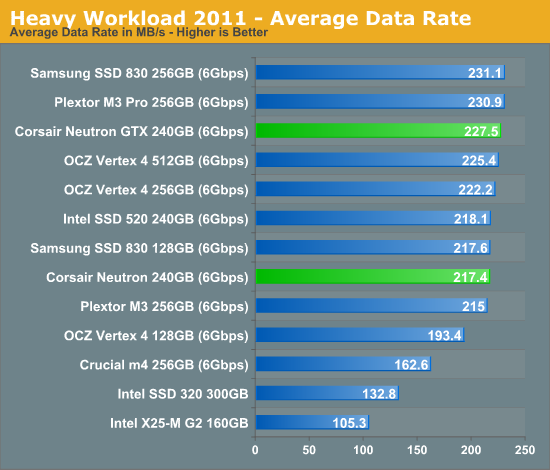
Without a doubt, Corsair's Neutron GTX is among the fastest drives we've tested here. In our most stressful use case, the Neutron GTX doesn't even break a sweat. The standard Neutron isn't too far behind either, the GTX outpaces it by just under 5%.
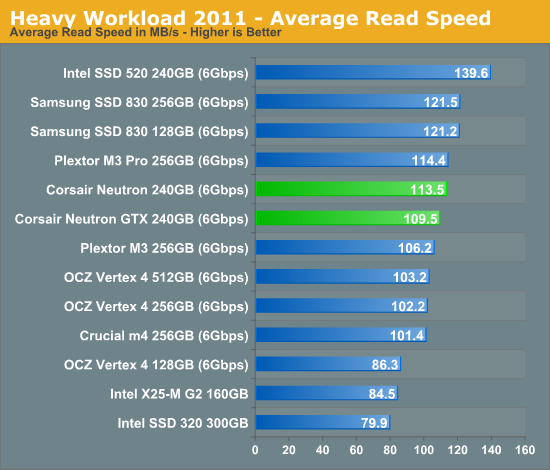
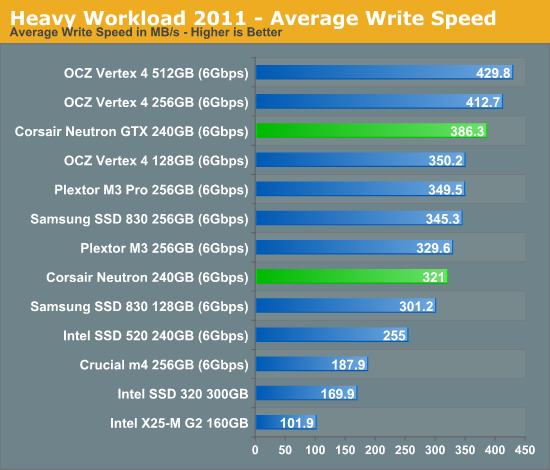
The next three charts just represent the same data, but in a different manner. Instead of looking at average data rate, we're looking at how long the disk was busy for during this entire test. Note that disk busy time excludes any and all idles, this is just how long the SSD was busy doing something:
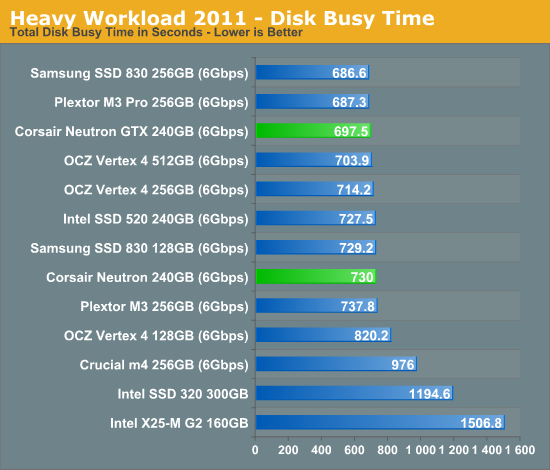
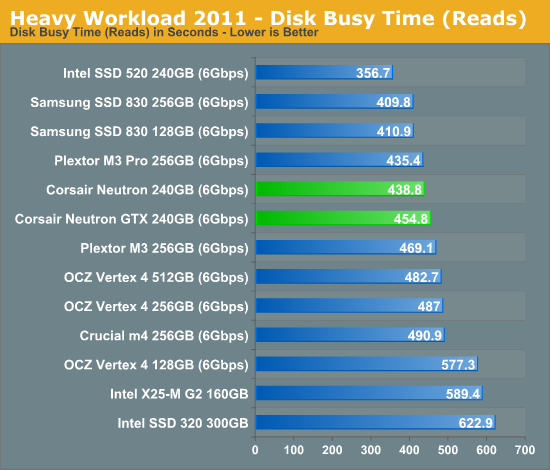
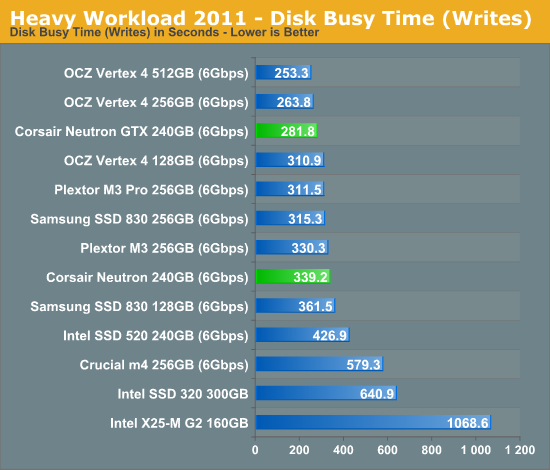










36 Comments
View All Comments
PommieB - Monday, August 20, 2012 - link
The Vertex 4 uses the 9145 controller, which as enterprise origins and was used by OCZ in there latest PCIe ssd drives, OCZ was obviously impressed with the controller to use it as there re-branded Everest controllers in the Vertex 4 and other ssd drives, so yes the Plextor M5 Pro is first ssd drive to have the 9187 Marvell controller.maximumGPU - Tuesday, August 21, 2012 - link
thanks :)DukeN - Monday, August 20, 2012 - link
For those of us hoping to put 3 or 4 of these in our systems..Please and thanks.
Zap - Monday, August 20, 2012 - link
Why does Corsair (and also Newegg) call it SATA 3?http://www.sata-io.org/developers/naming_guideline...
Proper terminology is to call it "SATA Revision 3.0" or "SATA 6Gb/s" and to NOT use "SATA III" or "SATA 3.0." This is because SATA II was often marketed as SATA 3Gb/s or SATA 300, so "3" is associated with the slower speed.
Beenthere - Monday, August 20, 2012 - link
Most consumers are interested in reliable, compatible, hassle-free PC hardware not the half-baked trick-of-the-week rushed out the door for huge profits. PC hardware review sites lose credibility when they hype half-baked products and gloss over obvious defects or down-play their significance.Many companies are quite successful selling quality, reliable products and providing excellent customer service - all at affordable prices. In fact that use to be the norm in the U.S. until some unscrupulous CEOs decided that they could reap more money in annual bonuses by shipping crap products and pretending there were no issues or defects.
Unfortunately for Corsair in recent years they have jumped on the growth-at-all-cost bandwagon by using contract suppliers. Corsair's numerous product lines are filled with documented defects be it SSDs, PSUs, H2O CPU coolers, etc. At one time I recommended Corsair RAM but even that seems to have dropped in reliability and compatibility recently so I no longer recommend any of their current products.
Shadowmaster625 - Monday, August 20, 2012 - link
Idle power consumption is stupidly bad. Samsung SSD830 is the reigning champion by far. It may not be the fastest, but it is competitive speed wise, and its low idle power just continues to own the competition. I wouldnt even consider any other drive for a notebook.Paapaa125 - Monday, August 20, 2012 - link
I have no clue why you keep on presenting the same data in two different charts: average data rate and disk busy time. Only one is enough. Showing the other serves no purpose at all so please pick one of them and start using it. Thanks!Mastadon - Monday, August 20, 2012 - link
What kind of TRIM does the Corsair controller use? Is it garbage collection after the fact, or on-the-fly?Mr Perfect - Wednesday, August 22, 2012 - link
I've always been under the impression that Garbage Collection, as defined by the drive makers, is not TRIM. Garbage Collection is done solely inside the drive by the controller with no regard for what the data in the flash is or what the OS is doing. TRIM is done through commands sent from the OS to the drive to tell it what flash is holding valid data, and what flash is no longer needed and can be erased. I think some drives even do both GC and TRIM. If he's saying TRIM, I'd take it to be the later case.phimac10 - Tuesday, August 21, 2012 - link
Thanks for a good insight in the SSD world.